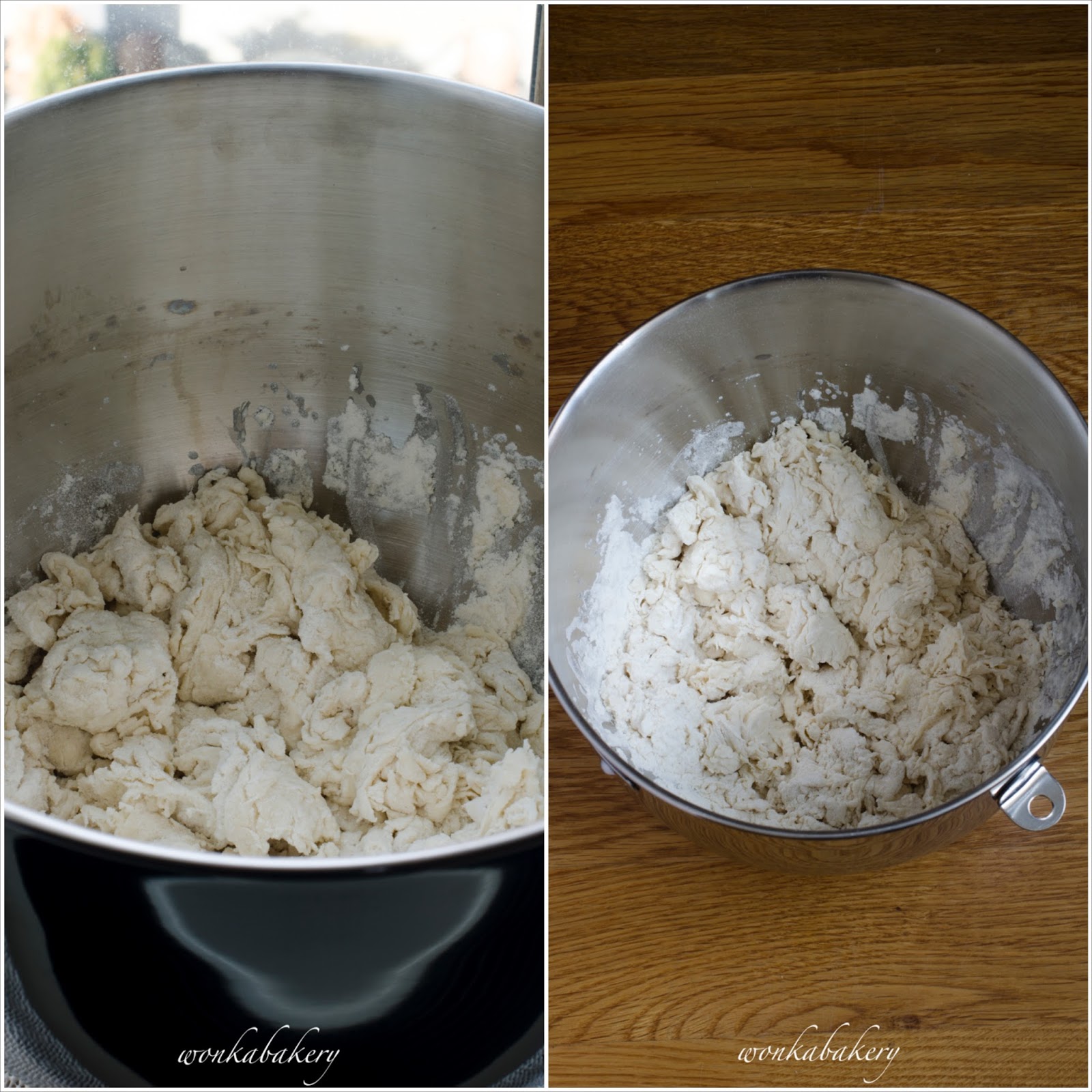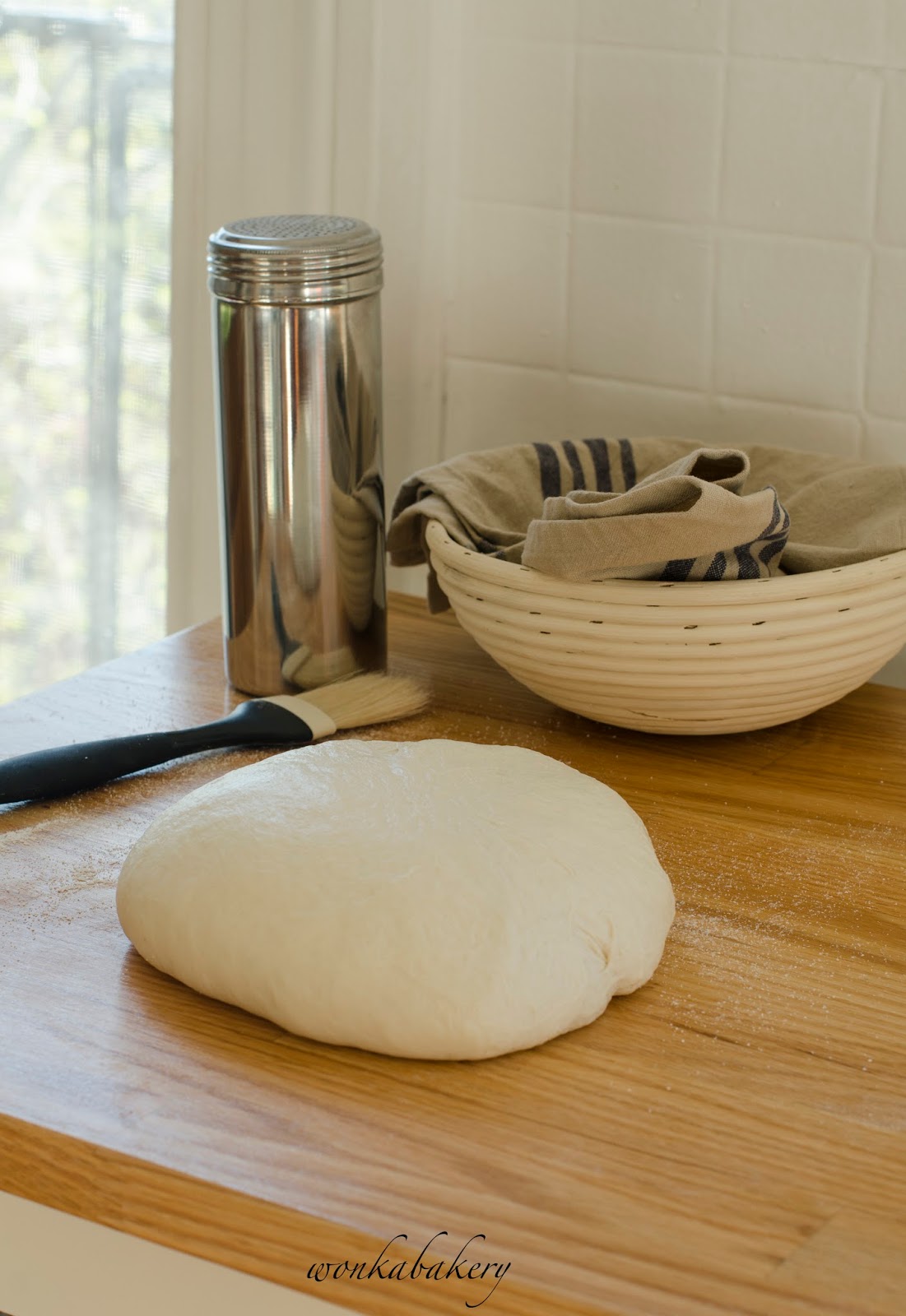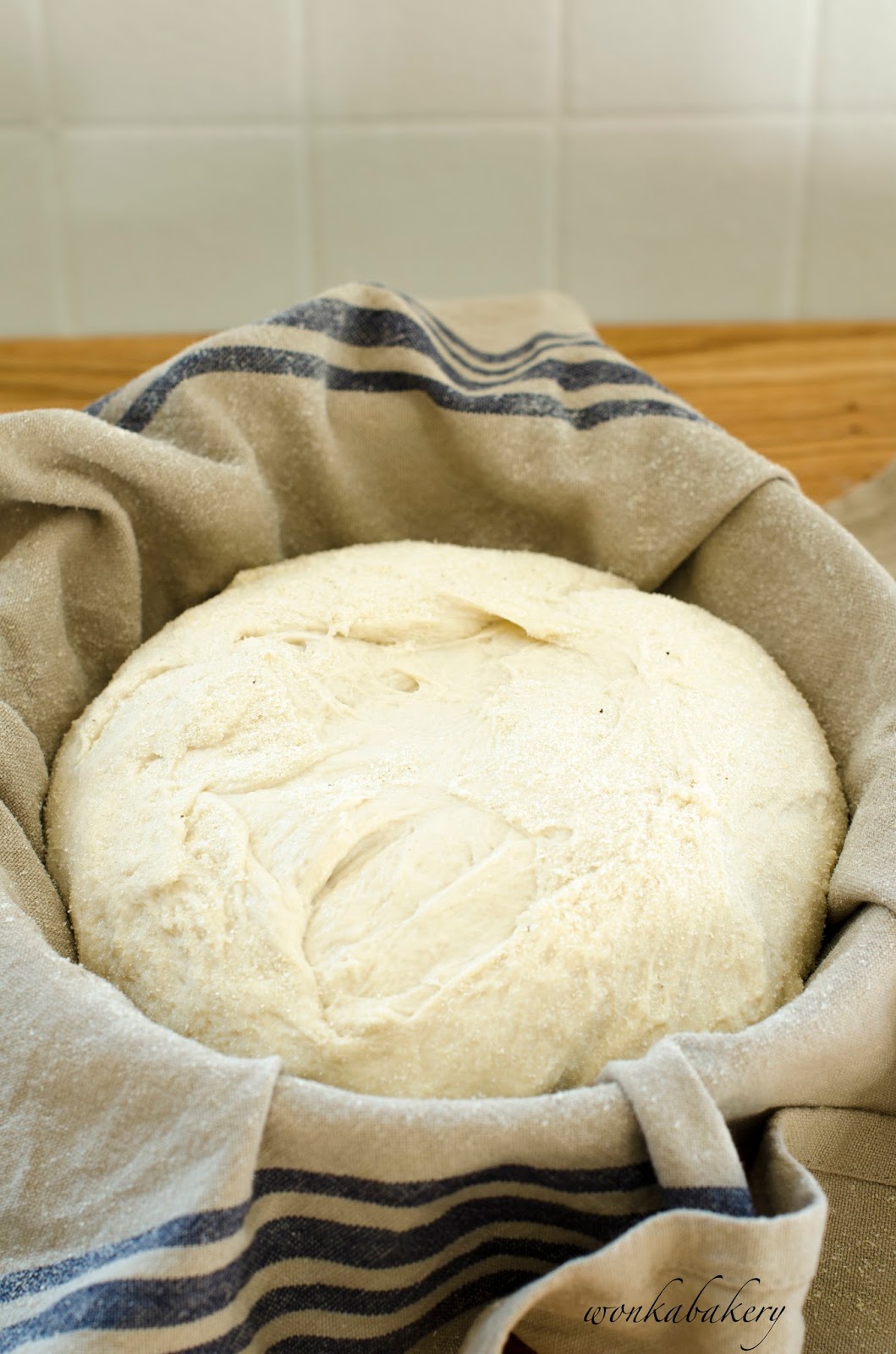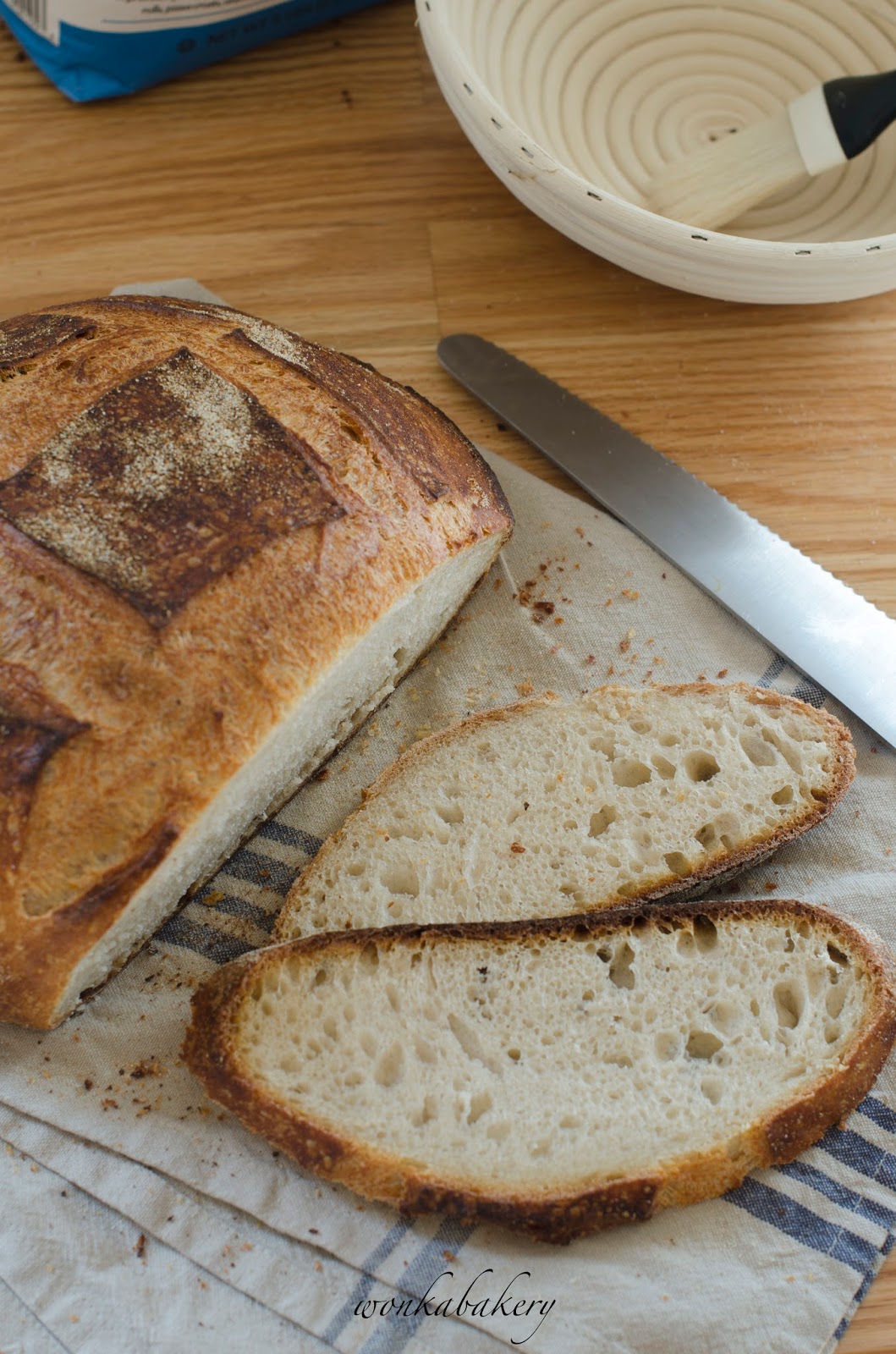It help me familiarize with the bread-making process and hopefully it will help also you.
You will baked the bread in a pre-heated dutch oven/cast iron, therefore make sure you have the right pot before starting.
LEVAIN (to be prepared the night before you intend to knead)
The levain simply is starter combination with a part of water and flour deducted from the total of the recipe.
The starter must be melted in water and consequently add flour energetically stirring all, avoiding creation of clumps, this liquid mix must ferment the all night without thermal changes.
Fermentations time are indefinite and really depend from the activity level of your starter, generally in order to obtain a levain ready to be bake time frame can be between 6 and 12 hours.
Usually I prepared it in the evening just before I go to sleep and it’s ready the following morning.
A levain is ready for our dough when it has increased its volume and you note bubbles on the surface. (see photo below)
|
WEIGHT
|
INGREDIENT
|
PERCENTAGE
|
|
110gr
|
Starter
|
100%
|
|
110gr
|
H2o room temperature
|
100%
|
|
110gr
|
King Arthur Unbleached White bread flour
|
100%
|
 |
| -Levain after a night fermentation- |
DOUGH
The dough includes all the ingredients in the recipe and the percentages are calculated on the weight of the flour without considering the levain.
This recipe has 60% hydration which will make the dough rather easy to work with since the hydration level is not that hight.
this will allow us to familiarize with the various process without failure risks which would occur with a too hydrated dough as this would discourage whoever attempts to bake for the first time.
I have to say that a dough with this hydration level will not have a greatly airy crumb, however it will be very satisfying and with an excellent taste.
|
WEIGHT
|
INGREDIENT
|
PERENTAGE
|
|
600gr
|
King Arthur unbleached White Bread flour
|
100%
|
|
360gr
|
H2o room temperature
|
60%
|
|
15gr
|
Sea Salt
|
2,5%
|
|
300gr
|
Levain
|
50%
|
METHOD
After weighing and organizing all the ingredients proceed with 1 hour autolyse gradually adding 300gr of water to all the flour using a wooden spoon.
Cover the bowl with cling film and have it rest for one hour at constant temperature of 75F.
After the above mention time combine to the autolitic mass the already prepared levain and begin manually kneading, add the dissolved salt in the remaining 60 gr of water and work out till obtaining a smooth and even dough.
Place in a large bowl and cover with cling film at this point our dough is ready for its first two hours raising at a controlled temperature of 71 F.
 |
| -Autolyse- |
After two hours transfer the dough in the fridge, I usually place it in the lower panels and have it continues its maturation, at this point I have to point out a note on sourdough.
We cannot call it sourdough if we have not had a long fridge maturation (known as “retard”) which usually goes from at least 12 hours to up.
The dough you see in the photos rested 45 hours in the fridge, usually I have it rest for less time (36-40 hours), this depends from your time available and how the dough reacts during its stay in the fridge.
In the fridge fermentation will never completely cease, it will only be slower therefore you will always still notice a mass increase.
When the mass has double in volume or after 36 hours remove the bowl from the fridge beginning the last phase at room temperature.
 |
| -Dough after 40 hours fridge maturation- |
In all the books I have read in this period and in all the websites I have visited everyone has their own technique in working cold doughs.
Someone leave it rest a little at room temperature before working on it, others (like me) immediately start handling it.
Usually I place the dough on my work surface slightly flour dusted then with wet hands I spread it on the table, delicately expelling all the gas formed within and I immediately begin folding it for three times, resting 20 minutes per folding.
While resting I leave it on the table top covered with a bowl.
After the lest folding shape the dough, in this case roundish shape since it will go in a round pot.
Place a clean cloth in your banetton or in a bowl, as long as it’s round and dust it with semolina or rice flour and place the dough in it with the smooth skin towards the bottom of the banetton/basket.
Pull in the corners of your cloth over the dough in order for it to begin rising process, it should be completed covered at a temperature of 77 F.
There is no exact time for the final rise, it depends from the room temperature, from the season and simply from how the dough reacts, therefore during this last and fundamental phase it’s important you keep it under control.
In standard condition it is ready to be baked after 2-3 hours.
I do well with the classic “finger test” for me to understand when it is ready to be baked.
Use your index finger delicately push into the side of the dough and start “feelings” how it reacts.
If the dough is tough and pushes out your print leaving no traces it will still need to rise.
If it is soft and full of air within with your print returning slowly the rising was good therefore time to preheat the oven.
I usually begin this test after the firs rising hour and continue doing so every 20 minutes roughly to keep it under control avoiding it over proofed, quite frustrating experience.
When the dough has reached half its rising (about 1 hour from complete rising) begin preheated oven at max. temperature 450 F.
Position a stone or a rack on the lower shelves in order to screen the heat and on the medium shelves position the dutch oven with the lid next to it.
Once you have reached 450F and when the dough is ready to be baked remove the pot and lid and carefully wearing oven gloves resistant to high temperature.
Dust the bottom of the pot with a little rice flour which better resist to high temperature compare to wheat flour.
Take the basket and flip the dough into the center of the pot.
Wet a razor blade or a sharp knife and cut the dough in order to have it evenly grow during the baking avoiding it to tear.
Spray the doughs’ surface with water, put the lid on and pop in the oven.
All the procedure above described will have to be done as quick as possible.
Therefore be well organized and prepare all the material in order to avoid loosing time or worst skipping important steps.
Baked at max temperature 420 F for the firs 30 minutes.
After the first half hour put the glove on and remove the lid than continue baking for additional 20/25 minutes at 370 F.
The bread will be ready once the crust will have an intense amber color, if you are unsure with a thermometer you can check the internal temperature of the bread, it should register between 210 F and 220 F.
Once your done baking turn off the oven slightly open the door and leave to rest 5-7 minutes.
Take out the pot than use a spatula to help you extract the bread than let it cool down in a vertical position to preserve the crust.
And now….the most important….taste it!
I love white bread with peaches jam, delicious ;) and if you try this recipe let me know!











